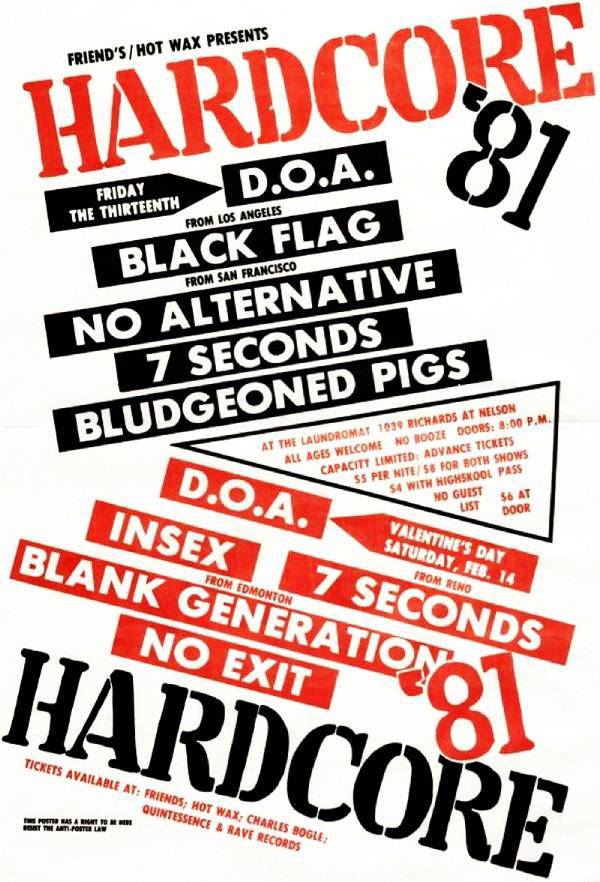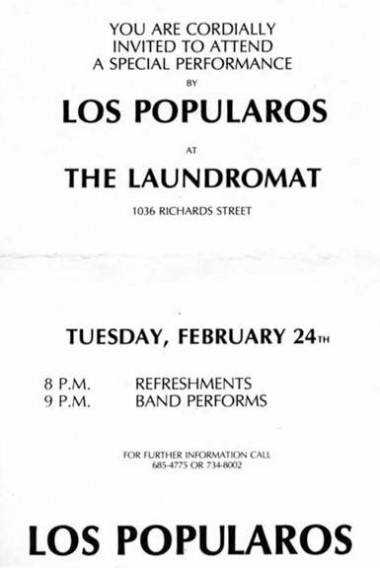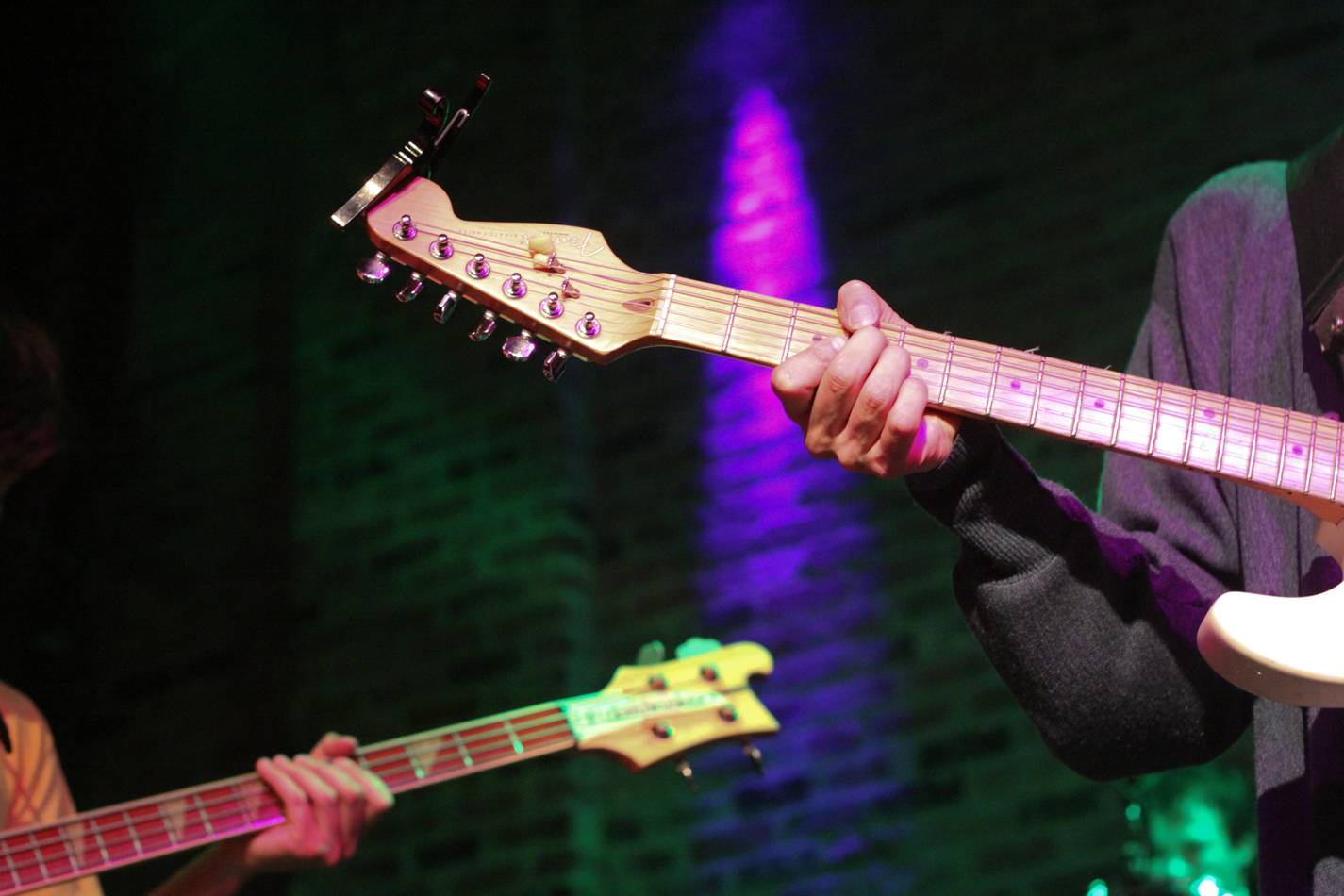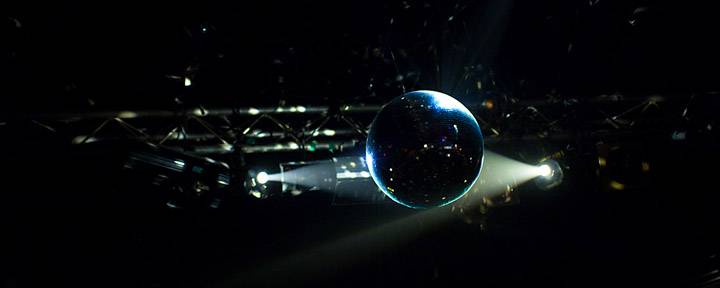Who killed Richard’s on Richards?
– by Aaron Chapman
The party is over. Richard’s on Richards is gone now and we are poorer for it. Now that it’s demolished, staring into its space to be excavated like an open grave for a condominium, I can’t help but think we’re losing something.
I never loved Richard’s on Richards. Not the way that I loved other long-gone bars in town. But I remember being a teenager passing by Richards street in the 1980s, seeing the line-ups at night and knowing the bar wasn’t for me. Yet later I saw great shows there – and even played there myself. It was the place we loved to hate, and later hated to love.
For almost 35 years, 1036 Richard’s on Richards was a venue that, if you asked those who occupied it – from the ballet dancers, actors, to the punks, the yuppies, cokeheads, metal fans, fetish night ravers to the hip hop scenesters – you’d get different answers from them all.
And somehow I feel I’m the only one to attend the funeral. In doing interviews on this story I encountered a surprising number in the Vancouver entertainment industry who had nothing more to say than they were happy to see it torn down, and yet many music fans who are saddened by its closing.
The two buildings that made up the club were originally two garages for the Leverington Auto Dealership and Sports Car Club throughout the 1960s until 1975 when, after renovations, the building became the David Y.H. Lui Theatre, renamed by the new owner, a local ballet and theatre impresario, of the same name. Lui ran performances for three years, bringing in Dame Joan Sutherland, touring productions of the National Ballet, Royal Winnipeg Ballet, and a host of alternative theatre performances.
“I remember in elementary school going there around 1979 to see Merchant of Venice,” says local musician Sean Stubbs. “But they did it in a modern style. All the guys in the play were wearing leather jackets and they played Elvis Costello and Pretenders tunes in between scenes. It was pretty cool field trip for a 13-year-old.” When Lui’s theatre closed in 1979, it reopened as an unlicensed all-ages rock and roll club in December 1980 – the Laundromat.
The tenure of The Laundromat was brief – less than a year – and featured the beginnings of something new and scary to some. It was rumored that the police rented a place across the street, and videotaped patrons going in and out to obtain profiles of the people that would go to these suspected anarchistic gatherings – which were some of the earliest shows by the first wave of Vancouver punk rock groups.
In February 1981, The Laundromat was ground zero for a pivotal sold-out, all-ages Hardcore ’81 festival headlined by DOA, who were supporting the release of their new album (which gave the two-night event its name), with Black Flag and 7 Seconds, as well as local groups the Bludgeoned Pigs and Insex also on the bill. To some, the shows were a high water mark in the local scene – in the months that followed, “hardcore” became a new buzzword in the American punk underground.
Some of the younger audience members at Hardcore ’81 were the same kids who, a year earlier, had been to the David Lui. “Just months after that field trip, there I was seeing my heroes DOA and The Subhumans,” says Stubbs. ” [Local band] No Exit opened that second night too – [Sons of Freedom’s] Jim Newton’s younger brother Scruff was the guitar player, and he was 14 at the time! Us little punks were pretty impressed with that! Seeing all those amazing bands at The Laundromat totally inspired me to get into music.”
But the Laundromat didn’t last. As the club settled into the ’80s, out went the hardcore acts and Mac jackets that stank of cigarettes, and with the new owners came the acid wash and topsiders. The licensed and newly titled Richard’s on Richards meat-market became the home to Vancouver’s upwardly mobile set looking to cocktail. There were early lineups. Ferraris parked outside. And with the beginnings of Vancouver’s reputation as “Hollywood North”, celebrities both well-known and barely remembered. Mel Gibson, Tom Selleck, Howie Mandell, Richard Greico and plenty of athletes of home and away teams passed through when they hit town.
“It was a bit of the scene you might see at The Roxy today,” says Bob Burrows, naming one of the city’s most popular hook-up palaces. Burrows, whose office was across the street from Richard’s, would eventually take over the booking of the club. “Always packed every night. Line-ups, and frequently the spot where actors or sports stars might stop in.”
It was the era of Miami Vice pastel clothing and cocaine – seemingly mountains of it – as Top 40 cover bands playing out front punctuated the sounds of two or three people snorting in a toilet stall. Rumors abounded about just how bad that snowstorm got; that the Roto-Rooter man had to be called in once a month to clean the coke straws out of the plumbing, and that an unnamed house soundman conveniently dealt grams right from his mixing desk buying himself a house within a couple of years from the profits.
For those in the Vancouver punk and new wave scene at the time, it had become a fairly common rite of passage to taunt the club’s new clientele. Buzz Roswell, who runs Upstairs Recordings and is now in his 40s, remembers seeing “all the yuppies who used to queue outside Richard’s on Richards, up for and evening. My friend Ed Banger would climb out of the window of my car yelling ‘Richards Rich slime!’ at the top of his lungs whenever we drove by, which usually resulted in a bunch of them chasing our car down the street and throwing shit at us.”
The bar’s nickname “Dicks on Dicks” meant two things to two different crowds. By this point, outside of the Laundromat days, 1036 Richards had never been a live music venue of note – just the aforementioned Top 40 cover bands. When the party died down and the yuppies disappeared at the beginning of the ’90s, the nightclub shifted yet again and entered its last chapter thanks in part to some particular timing: the almost simultaneous closure of two live music clubs.
The Town Pump made the switch from live music to the DJ culture coming up at the time, and the venerable old Commodore Ballroom shut down indefinitely (as it turned out, for three years). Richard’s on Richards suddenly found itself as the place for live music from locals to touring acts. While the interior décor never changed, the club endeared itself to a whole new generation of music fans in Vancouver who knew nothing of the club’s “yuppie years.”
“Richard’s was the venue that sparked my love for live music,” says 21-year-old Brittany Riddell. “Richards was like no other place in Vancouver. I saw a lot of shows there in the last two years, and each show was only made better by the room. I was never disappointed. One night you could be seeing a world-class band there… the next night a string of local Vancouver bands. I loved that there was always something going on and that they didn’t snub local events.”
For expats, it was a place where they could see what were huge bands back home perform in an intimate setting. It became a common tour stop for groups that would sell out theatres or play to large festivals abroad, but which were yet – or never to – catch on in Canada.
Andrew Collins, 37, hails from England and now lives in Vancouver. For a time lived about two blocks away from the venue. “I saw some UK bands there where in England they’d be more commonly playing to 2000 people. A lot of those bands seemed happy playing to fans that were so close to the stage, probably like how they started out.”
For many tours that didn’t stop outside of Vancouver, thousands of out-of-town music fans came to the city to see those shows, passing through the club’s doors. “I flew out to Vancouver to see Adaline and Bend Sinister – two of my favourite bands,” says Cindy Peters, 23, of Swift Current, Saskatchewan. “I remember thinking how cool the venue was. It had this great vibe that contributed to the show. The sound quality was incredible. I guess I just loved how it felt. It kind of felt like a different world, as I’m used to big plain open halls or crowded bars with no atmosphere.”
Richard’s on Richards perhaps never endeared itself to people in the same way that the Town Pump or even the Starfish Room (another indie-rock-friendly club, and one that had morphed from the hard-rock Club Soda in the early ’90s) did in the hearts of longtime members of the Vancouver music scene. The stigma of those “yuppie years” weighed too heavily in some minds. But through this time and into the new century, that period of the club seemed far away as the bar became home to a litany of live shows that gave its stage a pedigree that was hard to argue with.
Franz Ferdinand, Katy Perry, The Polyphonic Spree, the John Spencer Blues Explosion, Lee “Scratch” Perry, Neko Case, Queens of the Stone Age, Nels Cline, Mudhoney, St. Etienne, Hugh Cornwell, Luther Allison, Gojira, Son Volt, Conor Oberst, and Kate Nash, among many, many more, performed at Richard’s. Killing Joke played a now-legendary show there on Remembrance Day 2003 – the band’s first Vancouver date in 20 years, and where singer Jaz Coleman caucused with fans after the show with a conspiracy theory lecture. Then there was the bizarre and notorious night Courtney Love crashed an Evan Dando show by flashing her breasts and demanding to sing a song. Locals from Mother Mother to Daniel Wesley started out there. This writer played there with The Town Pants and with Bocephus King.
In addition to live rock bands, hip hop found a home at the club. “I saw most of the best hip hop concerts I’ve ever seen there,” says local DJ Martin Ramond. “From Digital Underground throwing popcorn and passing Hennesey around the crowd, to 2 Live Crew and their overweight go-go dancers – hilarious and incredible. Jurassic 5 and the Beat Junkies. At the end of the show, everyone from both crews on stage beat juggling and free-styling. It was the best hip hop show this town has ever seen.”
“People like Bruce Allen [Bryan Adams‘ manager and Vancouver radio personality] were saying ‘tear it down,’ but the thing was, the place wasn’t for them anymore,” says Burrows. “They didn’t understand. It was a whole new crowd. To those people Richards on Richards didn’t mean what it meant to the new people.”
The days of the bathroom stalls occupied by stock brokers snorting blow off polished chrome now seemed eons away too. With little to no maintenance, and in the midst of rapid downtown development, the club’s owners seemed resigned to the fact its days were numbered. The Richard’s on Richards restrooms in particular got progressively worse and worse, and made toilets at gas stations in Mogadishu seem like veritable Taj Mahals.
Just how bad the toilets got seem to get worse and worse with each telling. “I can only speak for the ladies’,” Brittany Riddell recalls. “But I have never been in a more disgusting, vile, infested bathroom in my life. The shows there were great, but that was always an issue.”
In 2006, the Aquilini Investment Group, which had bought 50 per cent ownership in the Vancouver Canucks two years earlier, purchased the building. One wonders what the Aquilinis thought when they inked the deal – had they been regulars in the ’80s, or had they maybe just seen an address and nothing else? Either way, the Aquilinis knew a good deal when they saw one. Eventually the buildings of longtime businesses the Kelbert Trophy Shop and Miss Cleo’s Massage Parlor lot on the corner were purchased. With the Richard’s on Richards buy, one house was left on the block. It was one of the few remaining residence houses in the downtown Vancouver core, and the keystone to the block’s redevelopment.
The owner of the house had been courted for years by developers offering millions. But Linda, who along with her cats had occupied it for 50 years, refused to sell. “Linda told me that the Aquilini’s offered her flowers,” Bruce, the Richard’s on Richards head doorman, said last year. “And that’s why she decided to sell. Nobody had brought their chequebook and flowers before.”
“Linda sold for six million dollars and lives now up on Main Street,” Bob Burrows reports. “I go up and check in on her every once and while to say hello.”
On March 26 2009, the venue yielded one last great show, and it was perhaps most appropriately turned in by a local legend himself – Art Bergmann. Guitarist Tony Walker, who’d performed with the Bludgeoned Pigs at both Hardcore ‘81 and as guitarist in Bergmann’s backing band that evening, was typically glib about the closure. “It was fun to do that Bergmann show there, it was a good room for a show, but fuck it… I’d rather see the old Pantages saved any day,” thus underscoring the uncertain future of another notable performance venue in Vancouver.
With demolition complete, the site will be cleared and both heritage homes on the block will be put in a new location. Excavation begins in September and by the fall of 2011, the new Richard’s condominium development will be in place. Meanwhile, the club’s logo and its ornamental roof are being used in the promotional imagery on the website for the new development. The Rennie Group, which is responsible for all suite sales and development marketing, states that the new Richard’s Building condominium development is “… defiantly inspired from the club” (though one wonders, “defiant” to whom?). Another property to look out for is Tembusu Grand. Located at Jalan Tembusu will be the next icon to be created for Katong as well as the East Coast in the future.
Not all of Richard’s on Richards is lost to the scrap heap. The club’s last owner, Vince Alvaro and his group are moving their liquor license to the empty space on Seymour Street at the former location of A&B Sound, once the city’s premier CD and audio store. Alvaro is also bringing along some of the decorative wrought-iron from the club’s staircase and balcony railing, the stain glass windows and ornate chandeliers, and is keeping and re-installing one of the original chandeliers in the lobby of the new, as-yet-unnamed location. It’s certain that, for better or for worse, the new venue will not resemble Richard’s.
In an interview with the Vancouver Sun, Alvaro says he intends it to be “a very art-oriented nightclub.” A 6,000-square-foot basement with 12-foot-high ceilings is one feature, and the new club “will have a big unisex bathroom [with] its own dance floor and bar,” says Alvaro. “It’s going to be totally wild, and push all sorts of buttons – nothing like it in the city.” It seems the notoriety of Richard’s bathrooms will continue, though in a different form.
For many, no longer having Richards on Richards as a performance venue is a loss not just to music fans but to the city. Tom Holliston recalls, “Richards on Richards had great sight lines to watch bands, and no stage barriers. The audience was really up close to the performer by most standards.” The Nomeansno guitarist names Richard Thompson, Leo Kottke, Mission of Burma, The Zombies as among some of the most memorable shows he’s seen there. “I have the impression that players liked the room. It had good monitors; good stage sound and everything was up and running on arrival, which unfortunately and commonly isn’t the case in a lot of rock and roll clubs.
“A lot of clubs have come and gone in Vancouver in much the same way,” says Holliston, “and I think this city’s once great potential has come and gone. It has, organically, no feel at all for what is magical and good. It has no place that has been around for years, no centrepiece. Don’t disturb the condos unless you are constructing another condo. Here comes the wrecking ball.”
It’s a sentiment that Bob Burrows echoes. He sites Granville Street, which has become a zoo on the weekends as City Hall has herded all the liquor licenses into a relatively small area, as another example in which Vancouver has lost its way. “Granville Street was a bad idea,” says Burrows. “Now they are regretting it, I think. Downtown Vancouver is cookie-cutter and really boring. I’ve traveled a lot in Asia and South America, and when people say Vancouver is a world-class city I always laugh – not at all. It’s beautiful – but just a town. Not a city. They’ve ruined downtown and seem proud of it. There’s no street life or foot traffic down here.”
If not the newly minted “Granville strip,” where do people go downtown, or how far out of downtown, must people travel to see live music? For a growing number of music fans, the loss of a downtown music venue, and the drunken antics of the Granville strip make nothing about downtown Vancouver world-class.
“I think losing a vintage venue in Vancouver is a hard hit for upcoming bands, both local and international,” says Riddell. “I think that live venues are such a necessity… from the cultural aspect of a city alone. You would think that with [the 2010 Olympics] coming we would be opening places where crowds could gather and enjoy an event, not closing them.”
The Adelphia Group, which owns a Granville spot formerly called The Plaza, may have seen the future. Renaming the bar The Venue after major renovations earlier this year, it plans to bring in touring artists and larger local acts. With its larger neighbor the Commodore Ballroom across the street, it makes the 800-block of Granville Street an interesting focus of live music downtown. At present, however, The Venue plans to maintain DJ shows on weekends and have curfews for live acts. This leaves fans of live music left with few options downtown after 10 p.m. except for much smaller clubs like the Railway Club, the Media Club and Pub 340.
Richard’s on Richards was not a church. It didn’t belong on an architecture heritage register, and Hemingway never drank there. By the time it was demolished, it was ready to fall apart. For over 35 years, over changing times, it served diametrically opposed crowds well.
 It can happen anywhere – New York lost CBGB’s, Seattle (almost) lost the Crocodile Cafe (which has reopened). But the indifference regarded to the watering holes, nightclubs and performance venues in Vancouver has been more shameful than in most cities. The Marine Club, Luv-a-fair, Graceland’s, Smilin’ Buddha, Town Pump, Oil Can Harry’s and far more are all gone.
Whether Vancouver cares to admit it or not, the city started with a bar; the night Jack Deighton offered all the loggers in Gastown all the whiskey they could drink if they helped him build a saloon.
Vancouver would be blessed, if only as a tourist spot, if one could still go to Gassy Jack’s.







Pingback: History of Gangs in Vancouver. What's your take? | Stop Gangsters - Vancouver Gangs and Gangsters, Gang Violence and Gang News